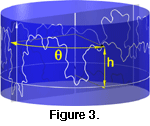PARAMETRIC FORMULATION FOR POINTS
ALONG THE SUTURE LINE
 Sutures are three-dimensional structures (Figure
3), but suture lines are usually illustrated as two-dimensional, open curves in a plane. When viewed in three dimensions, a suture appears as a closed orbital path around the circumference of the phragmacone. Therefore, the suture line is a three-dimensional, closed curve. It can be described using cylindrical coordinates. The position of points along the suture line can be measured in terms of an angle around the circumference of the phragmacone
(theta), the position along the shell's length
(h) and the distance from the center of the shell whorl (r). Points along the suture line are described by parametric equations, with
n (the index of the point) as the variable. If there are N points along the suture line, then the position
S of the nth point (the point with index n of N) can be described as
Sutures are three-dimensional structures (Figure
3), but suture lines are usually illustrated as two-dimensional, open curves in a plane. When viewed in three dimensions, a suture appears as a closed orbital path around the circumference of the phragmacone. Therefore, the suture line is a three-dimensional, closed curve. It can be described using cylindrical coordinates. The position of points along the suture line can be measured in terms of an angle around the circumference of the phragmacone
(theta), the position along the shell's length
(h) and the distance from the center of the shell whorl (r). Points along the suture line are described by parametric equations, with
n (the index of the point) as the variable. If there are N points along the suture line, then the position
S of the nth point (the point with index n of N) can be described as
S(n) = ( r(n), theta(n), h(n) )
1
By using parametric equations, the problem of non-uniqueness is eliminated, since each
h(n) is unique with respect to n. This is in contrast to the more typical formulation where points are defined in linear terms (e.g.,
Canfield and Anstey 1981 using Fourier series to describe nautilitic suture patterns, and
Daniel et al. 1997,
Hassan et al. 2002 using finite-element analyses).
A complete mathematical description of suture patterns would use the shape of the shell that bounds the septum, rather than cylindrical coordinates. Most cephalopod shells are logarithmically spiraled cones (although the heteromorph ammonites deviate radically from the logarithmic model). Unfortunately, the shape of the shell is seldom reported in detail in the literature, and this study will use a cylindrical coordinate system. The suture patterns used in this study were from published suture patterns (principally
Wiedmann
1969), illustrated as two-dimensional curves. Information on
h is incomplete in these sources, and information of the coiling parameters (e.g.,
W and D, Raup
1967), as well
r, are missing. It is possible, however, to compensate for the lack of complete information on
h by defining an origin on the suture line (h(0) is defined as 0 where the suture crosses the venter). Published suture lines commonly do not include information on r or the cross-section of the whorl at the position of the suture was drawn, and thus it is not possible to compensate for its absence so
r is omitted from this analysis. (It should be noted that this is not always the case; see, for example,
Olóriz et al.
1997.) The suture line is scaled such that the length of the half-suture is pi; this characterization has the effect of treating the cross-section of the whorl as a circle with a radius of 1.
h is scaled such that proportionality between h and the suture length is maintained.
This method requires the complete suture, around the entire circumference of the phragmacone (from 0 to 2
pi). Suture patterns are often not published in their entirety, but omit the internal portion of the pattern that is covered by the succeeding volution. Such published patterns are not amenable to the method as described here, although it may be possible to extend the method. Some shelled cephalopods, most notably the heteromorph ammonites, are not coiled to the degree that the shell formed by the more mature animal overlaps the earlier formed shell; several of the suture patterns used in this analysis are of heteromorph
taxa.

 Sutures are three-dimensional structures (Figure
3), but suture lines are usually illustrated as two-dimensional, open curves in a plane. When viewed in three dimensions, a suture appears as a closed orbital path around the circumference of the phragmacone. Therefore, the suture line is a three-dimensional, closed curve. It can be described using cylindrical coordinates. The position of points along the suture line can be measured in terms of an angle around the circumference of the phragmacone
(theta), the position along the shell's length
(h) and the distance from the center of the shell whorl (r). Points along the suture line are described by parametric equations, with
n (the index of the point) as the variable. If there are N points along the suture line, then the position
S of the nth point (the point with index n of N) can be described as
Sutures are three-dimensional structures (Figure
3), but suture lines are usually illustrated as two-dimensional, open curves in a plane. When viewed in three dimensions, a suture appears as a closed orbital path around the circumference of the phragmacone. Therefore, the suture line is a three-dimensional, closed curve. It can be described using cylindrical coordinates. The position of points along the suture line can be measured in terms of an angle around the circumference of the phragmacone
(theta), the position along the shell's length
(h) and the distance from the center of the shell whorl (r). Points along the suture line are described by parametric equations, with
n (the index of the point) as the variable. If there are N points along the suture line, then the position
S of the nth point (the point with index n of N) can be described as